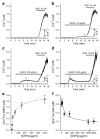TRP Channels as Cellular Targets of Particulate Matter
- PMID: 33803491
- PMCID: PMC7967245
- DOI: 10.3390/ijms22052783
TRP Channels as Cellular Targets of Particulate Matter
Abstract
Particulate matter (PM) is constituted by particles with sizes in the nanometer to micrometer scales. PM can be generated from natural sources such as sandstorms and wildfires, and from human activities, including combustion of fuels, manufacturing and construction or specially engineered for applications in biotechnology, food industry, cosmetics, electronics, etc. Due to their small size PM can penetrate biological tissues, interact with cellular components and induce noxious effects such as disruptions of the cytoskeleton and membranes and the generation of reactive oxygen species. Here, we provide an overview on the actions of PM on transient receptor potential (TRP) proteins, a superfamily of cation-permeable channels with crucial roles in cell signaling. Their expression in epithelial cells and sensory innervation and their high sensitivity to chemical, thermal and mechanical stimuli makes TRP channels prime targets in the major entry routes of noxious PM, which may result in respiratory, metabolic and cardiovascular disorders. On the other hand, the interactions between TRP channel and engineered nanoparticles may be used for targeted drug delivery. We emphasize in that much further research is required to fully characterize the mechanisms underlying PM-TRP channel interactions and their relevance for PM toxicology and biomedical applications.
Keywords: TRP channel; TRPA1; TRPM2; TRPM8; TRPV1; TRPV4; diesel; nanoparticle; particular matter; smoke.
Conflict of interest statement
The authors declare no conflict of interest.
Figures





Similar articles
-
TRP channels and traffic-related environmental pollution-induced pulmonary disease.Semin Immunopathol. 2016 May;38(3):331-8. doi: 10.1007/s00281-016-0554-4. Epub 2016 Feb 2. Semin Immunopathol. 2016. PMID: 26837756 Free PMC article. Review.
-
Activation of transient receptor potential ankyrin-1 (TRPA1) in lung cells by wood smoke particulate material.Chem Res Toxicol. 2013 May 20;26(5):750-8. doi: 10.1021/tx400024h. Epub 2013 Apr 25. Chem Res Toxicol. 2013. PMID: 23541125 Free PMC article.
-
Transient Receptor Potential (TRP) Channels in Airway Toxicity and Disease: An Update.Cells. 2022 Sep 17;11(18):2907. doi: 10.3390/cells11182907. Cells. 2022. PMID: 36139480 Free PMC article. Review.
-
Redox regulation of transient receptor potential channels.Antioxid Redox Signal. 2014 Aug 20;21(6):971-86. doi: 10.1089/ars.2013.5616. Epub 2013 Oct 25. Antioxid Redox Signal. 2014. PMID: 24161127 Review.
-
Transient receptor potential ion channel function in sensory transduction and cellular signaling cascades underlying visceral hypersensitivity.Am J Physiol Gastrointest Liver Physiol. 2017 Jun 1;312(6):G635-G648. doi: 10.1152/ajpgi.00401.2016. Epub 2017 Apr 6. Am J Physiol Gastrointest Liver Physiol. 2017. PMID: 28385695 Review.
Cited by
-
Silica Nanoparticles Inhibit Responses to ATP in Human Airway Epithelial 16HBE Cells.Int J Mol Sci. 2021 Sep 21;22(18):10173. doi: 10.3390/ijms221810173. Int J Mol Sci. 2021. PMID: 34576336 Free PMC article.
-
Expression and distribution of the transient receptor potential cationic channel ankyrin 1 (TRPA1) in the human seminal vesicles.Health Sci Rep. 2022 Dec 11;6(1):e987. doi: 10.1002/hsr2.987. eCollection 2023 Jan. Health Sci Rep. 2022. PMID: 36519080 Free PMC article.
-
TRPA1-Related Diseases and Applications of Nanotherapy.Int J Mol Sci. 2024 Aug 26;25(17):9234. doi: 10.3390/ijms25179234. Int J Mol Sci. 2024. PMID: 39273183 Free PMC article. Review.
-
Airway Exposure to Polyethyleneimine Nanoparticles Induces Type 2 Immunity by a Mechanism Involving Oxidative Stress and ATP Release.Int J Mol Sci. 2021 Aug 23;22(16):9071. doi: 10.3390/ijms22169071. Int J Mol Sci. 2021. PMID: 34445774 Free PMC article.
-
Proton-sensing ion channels, GPCRs and calcium signaling regulated by them: implications for cancer.Front Cell Dev Biol. 2024 Mar 5;12:1326231. doi: 10.3389/fcell.2024.1326231. eCollection 2024. Front Cell Dev Biol. 2024. PMID: 38505262 Free PMC article. Review.
References
-
- Nanoparticle Technology Handbook. Nano Today. 2007;2:45. doi: 10.1016/S1748-0132(07)70119-6. - DOI
-
- Wang J., Asbach C., Fissan H., Hülser T., Kuhlbusch T.A.J., Thompson D., Pui D.Y.H. How can nanobiotechnology oversight advance science and industry: Examples from environmental, health, and safety studies of nanoparticles (nano-EHS) J. Nanopart. Res. 2011;13:1373–1387. doi: 10.1007/s11051-011-0236-z. - DOI
-
- Xia T., Kovochich M., Brant J., Hotze M., Sempf J., Oberley T., Sioutas C., Yeh J.I., Wiesner M.R., Nel A.E. Comparison of the Abilities of Ambient and Manufactured Nanoparticles To Induce Cellular Toxicity According to an Oxidative Stress Paradigm. Nano Lett. 2006;6:1794–1807. doi: 10.1021/nl061025k. - DOI - PubMed
-
- Hamra G.B., Guha N., Cohen A., Laden F., Raaschou-Nielsen O., Samet J.M., Vineis P., Forastiere F., Saldiva P., Yorifuji T., et al. Outdoor Particulate Matter Exposure and Lung Cancer: A Systematic Review and Meta-Analysis. Environ. Health Perspect. 2014;122 doi: 10.1289/ehp/1408092. - DOI - PMC - PubMed
Publication types
MeSH terms
Substances
Grants and funding
LinkOut - more resources
Full Text Sources
Other Literature Sources
Medical
Research Materials

